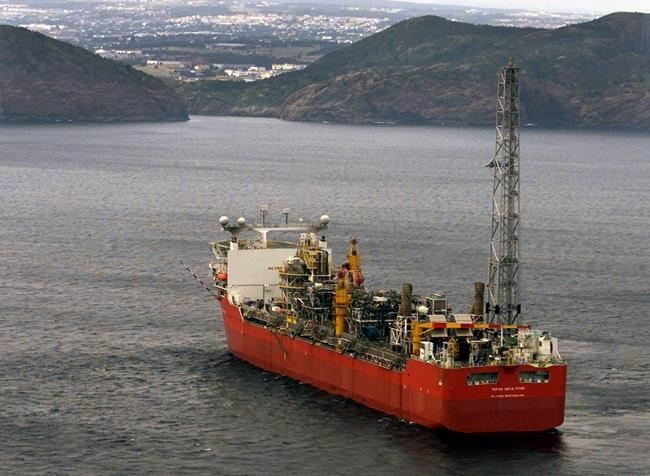ST. JOHN'S, N.L. — Newfoundland and Labrador's federally funded subsidies for offshore oil are a "misuse of funds" and another step in the wrong economic direction for the cash-strapped province, says a political scientist who has studied the province's oil sector.
Angela Carter, an associate professor at the University of Waterloo, says it's increasingly difficult to watch the government offer hundreds of millions of dollars in public money to oil companies while not taking effective steps toward building an economy that isn't reliant upon oil.
"What oil producers are trying to do is get whatever they can out of the remaining reserves," Carter, author of the 2020 book "Fossilized: Environmental Policy in Canada's Petro-Provinces," said in a recent interview. "They're leaning on governments like Newfoundland and Labrador that are in distress … to be propped up or bailed out for those last few drops. And that's being done not in the interest of governments, but for private interests."
She worries the latest offer — $205 million in cash and a $300-million break in royalties for the owners of the Terra Nova oilfield — will encourage other oil companies to seek similar treatment.
The Newfoundland and Labrador government has offered oil companies more than $280 million since December 2020 to restart projects in peril or to keep them in play. The money comes from a $320-million fund provided to the province by Ottawa, earmarked for safety improvements, maintenance and upgrades for facilities, research and development and clean technology in the oil sector.
"This is about jobs in our province," federal Natural Resources Minister Seamus O'Regan told reporters last September when the funding was announced. "This is about the future of our sector."
Until a tentative deal was announced on June 16, the province had been bracing for the abandonment of the aging Terra Nova field. With the breaks provided to its owners, the government will collect $35 million in royalties — about one-tenth of the full amount expected from the 80 million barrels left in the field.
Premier Andrew Furey and Energy Minister Andrew Parsons have justified the aid by saying if the project didn't go ahead, there'd be no royalties at all. And with the money coming from Ottawa, the move hasn't cost Newfoundland and Labrador a cent, nor could it have been spent elsewhere, they said.
"We're going to get money back from the indirect jobs and the direct jobs that come from this," Parsons told reporters in mid-June. "I think it's a really good move for this province … we've protected the future, we've saved jobs and we're using the resource in the best interest of the province."
Rob Strong is a St. John's-based consultant with decades of experience in the industry. Like Carter, he believes government has set a precedent with the $300-million royalty break for Terra Nova. "If I was an oil company, I'd be looking for the same sort of deal," he said in an interview this week.
Strong said he worries Newfoundland and Labrador's bargaining position is "not as great as we were led to believe." Other jurisdictions, such as Guyana, produce the same light sweet crude with similar emissions but for lower prices, he said.
Carter questions whether governments should be giving public money to oil companies at all, especially based on promises of stability and jobs. "The sector is interested in profits from extraction, and yet we have been told … this is about jobs," she said. "This is a doubling down on the oil sector."
She points to a January 2021 study from economist Jim Stanford at the Centre For Future Work showing the Canadian oil sector has been shedding jobs since 2014, even though production has gone up. The oil industry, the report said, is not a reliable source of future jobs.
In Newfoundland and Labrador, direct employment with offshore projects fell from nearly 13,750 jobs in 2014 to about 4,500 in 2019, according to benefits reports filed by operators. That drop is largely due to the end of construction on the Hebron project, which began pumping oil in 2017. As of May 2021, production levels in the province are some of the highest they've been in decade, says a report from the provincial offshore regulator.
"A lot of the (oil) jobs are construction jobs, and they're temporary," said Chris Severson-Baker, Alberta's regional director at the Pembina Institute, a national energy think tank. Once construction is finished, companies are increasingly turning to automation and artificial intelligence to shed staff, he said in an interview.
"Everywhere they can, they're cutting costs," he said. "And this is before any kind of real reduction in demand, globally. This is in response to the competitive price environment that oil and gas has been in for a while."
In Newfoundland and Labrador, those jobs are particularly precarious with no meaningful efforts from governments to build new industries for workers to turn to when fields run dry or — as was the case with Terra Nova — when progress halts because owners want to pull out, Carter said.
She said the government's choice to hand the federal money to oil companies rather than support laid-off workers directly through retraining or retirement packages is a "misuse of funds."
"Furey has got to create a (team), and get the people in the room to figure out what the next thing is," she said. "We gave a lot of public support and research dollars … to figure out a way to join this oil boom. So, same thing now, we need to do that again."
A spokeswoman for Furey, Meghan McCabe, said work is underway on a green transition. "We are developing a renewable energy plan with a clear and sustainable long-term vision for our province," she said in a statement Tuesday.
This report by The Canadian Press was first published July 2, 2021.
Sarah Smellie, The Canadian Press


